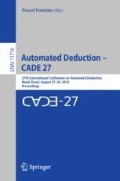Abstract
Many applications of theorem proving, for example program verification and analysis, require first-order reasoning with both quantifiers and theories such as arithmetic and datatypes. There is no complete procedure for reasoning in such theories but the state-of-the-art in automated theorem proving is still able to reason effectively with real-world problems from this rich domain. In this paper we contribute to a missing part of the puzzle: automated induction inside a saturation-based theorem prover. Our goal is to incorporate lightweight automated induction in a way that complements the saturation-based approach, allowing us to solve problems requiring a combination of first-order reasoning, theory reasoning, and inductive reasoning. We implement a number of techniques and heuristics and evaluate them within the Vampire theorem prover. Our results show that these new techniques enjoy practical success on real-world problems.
This work was supported by EPSRC Grant EP/P03408X/1. Andrei Voronkov was also partially supported by ERC Starting Grant 2014 SYMCAR 639270 and the Wallenberg Academy Fellowship 2014 – TheProSE.
Access this chapter
Tax calculation will be finalised at checkout
Purchases are for personal use only
Notes
References
Barrett, C., Fontaine, P., Tinelli, C.: The Satisfiability Modulo Theories Library (SMT-LIB) (2016). www.SMT-LIB.org
Claessen, K., Johansson, M., Rosén, D., Smallbone, N.: Automating inductive proofs using theory exploration. In: Bonacina, M.P. (ed.) CADE 2013. LNCS (LNAI), vol. 7898, pp. 392–406. Springer, Heidelberg (2013). https://doi.org/10.1007/978-3-642-38574-2_27
Comon, H.: Inductionless induction. In: Handbook of Automated Reasoning (in 2 vols.), pp. 913–962 (2001)
Cruanes, S.: Superposition with structural induction. In: Dixon, C., Finger, M. (eds.) FroCoS 2017. LNCS (LNAI), vol. 10483, pp. 172–188. Springer, Cham (2017). https://doi.org/10.1007/978-3-319-66167-4_10
Dixon, L., Fleuriot, J.: Higher order rippling in IsaPlanner. In: Slind, K., Bunker, A., Gopalakrishnan, G. (eds.) TPHOLs 2004. LNCS, vol. 3223, pp. 83–98. Springer, Heidelberg (2004). https://doi.org/10.1007/978-3-540-30142-4_7
Gupta, A., Kovács, L., Kragl, B., Voronkov, A.: Extensional crisis and proving identity. In: Cassez, F., Raskin, J.-F. (eds.) ATVA 2014. LNCS, vol. 8837, pp. 185–200. Springer, Cham (2014). https://doi.org/10.1007/978-3-319-11936-6_14
Kaufmann, M., Strother Moore, J., Manolios, P.: Computer-Aided Reasoning: An Approach. Kluwer Academic Publishers, Norwell (2000)
Kersani, A., Peltier, N.: Combining superposition and induction: a practical realization. In: Fontaine, P., Ringeissen, C., Schmidt, R.A. (eds.) FroCoS 2013. LNCS (LNAI), vol. 8152, pp. 7–22. Springer, Heidelberg (2013). https://doi.org/10.1007/978-3-642-40885-4_2
Kovács, L., Robillard, S., Voronkov, A.: Coming to terms with quantified reasoning. SIGPLAN Not. 52(1), 260–270 (2017)
Kovács, L., Voronkov, A.: First-order theorem proving and Vampire. In: Sharygina, N., Veith, H. (eds.) CAV 2013. LNCS, vol. 8044, pp. 1–35. Springer, Heidelberg (2013). https://doi.org/10.1007/978-3-642-39799-8_1
Leino, K.R.M.: Automating induction with an SMT solver. In: Kuncak, V., Rybalchenko, A. (eds.) VMCAI 2012. LNCS, vol. 7148, pp. 315–331. Springer, Heidelberg (2012). https://doi.org/10.1007/978-3-642-27940-9_21
Nieuwenhuis, R., Rubio, A.: Paramodulation-based theorem proving. In: Robinson, A., Voronkov, A. (eds.) Handbook of Automated Reasoning, vol. I, chap. 7, pp. 371–443. Elsevier Science (2001)
Nonnengart, A., Weidenbach, C.: Computing small clause normal forms. In: Handbook of Automated Reasoning (in 2 vols.), pp. 335–367 (2001)
Reger, G., Bjørner, N., Suda, M., Voronkov, A.: AVATAR modulo theories. In: 2nd Global Conference on Artificial Intelligence, GCAI 2016. EPiC Series in Computing, vol. 41, pp. 39–52. EasyChair (2016)
Reger, G., Suda, M., Voronkov, A.: New techniques in clausal form generation. In: 2nd Global Conference on Artificial Intelligence, GCAI 2016. EPiC Series in Computing, vol. 41, pp. 11–23. EasyChair (2016)
Reynolds, A., Kuncak, V.: Induction for SMT solvers. In: D’Souza, D., Lal, A., Larsen, K.G. (eds.) VMCAI 2015. LNCS, vol. 8931, pp. 80–98. Springer, Heidelberg (2015). https://doi.org/10.1007/978-3-662-46081-8_5
Rybina, T., Voronkov, A.: A decision procedure for term algebras with queues. ACM Trans. Comput. Logic 2(2), 155–181 (2001)
Schulz, S.: E - a brainiac theorem prover. AI Commun. 15(2–3), 111–126 (2002)
Sonnex, W., Drossopoulou, S., Eisenbach, S.: Zeno: an automated prover for properties of recursive data structures. In: Flanagan, C., König, B. (eds.) TACAS 2012. LNCS, vol. 7214, pp. 407–421. Springer, Heidelberg (2012). https://doi.org/10.1007/978-3-642-28756-5_28
Stump, A., Sutcliffe, G., Tinelli, C.: StarExec, a cross community logic solving service (2012). https://www.starexec.org
Sutcliffe, G.: The TPTP problem library and associated infrastructure. J. Autom. Reason. 43(4), 337–362 (2009)
Voronkov, A.: AVATAR: the architecture for first-order theorem provers. In: Biere, A., Bloem, R. (eds.) CAV 2014. LNCS, vol. 8559, pp. 696–710. Springer, Cham (2014). https://doi.org/10.1007/978-3-319-08867-9_46
Wand, D.: Superposition: types and induction. (Superposition: types et induction). Ph.D. thesis, Saarland University, Saarbrücken, Germany (2017)
Weidenbach, C.: Combining superposition, sorts and splitting. In: Robinson, A., Voronkov, A. (eds.) Handbook of Automated Reasoning, vol. II, chap. 27, pp. 1965–2013. Elsevier Science (2001)
Acknowledgements
We thank Andrew Reynolds for helping with obtaining CVC4 results.
Author information
Authors and Affiliations
Corresponding author
Editor information
Editors and Affiliations
Rights and permissions
Copyright information
© 2019 Springer Nature Switzerland AG
About this paper
Cite this paper
Reger, G., Voronkov, A. (2019). Induction in Saturation-Based Proof Search. In: Fontaine, P. (eds) Automated Deduction – CADE 27. CADE 2019. Lecture Notes in Computer Science(), vol 11716. Springer, Cham. https://doi.org/10.1007/978-3-030-29436-6_28
Download citation
DOI: https://doi.org/10.1007/978-3-030-29436-6_28
Published:
Publisher Name: Springer, Cham
Print ISBN: 978-3-030-29435-9
Online ISBN: 978-3-030-29436-6
eBook Packages: Computer ScienceComputer Science (R0)

